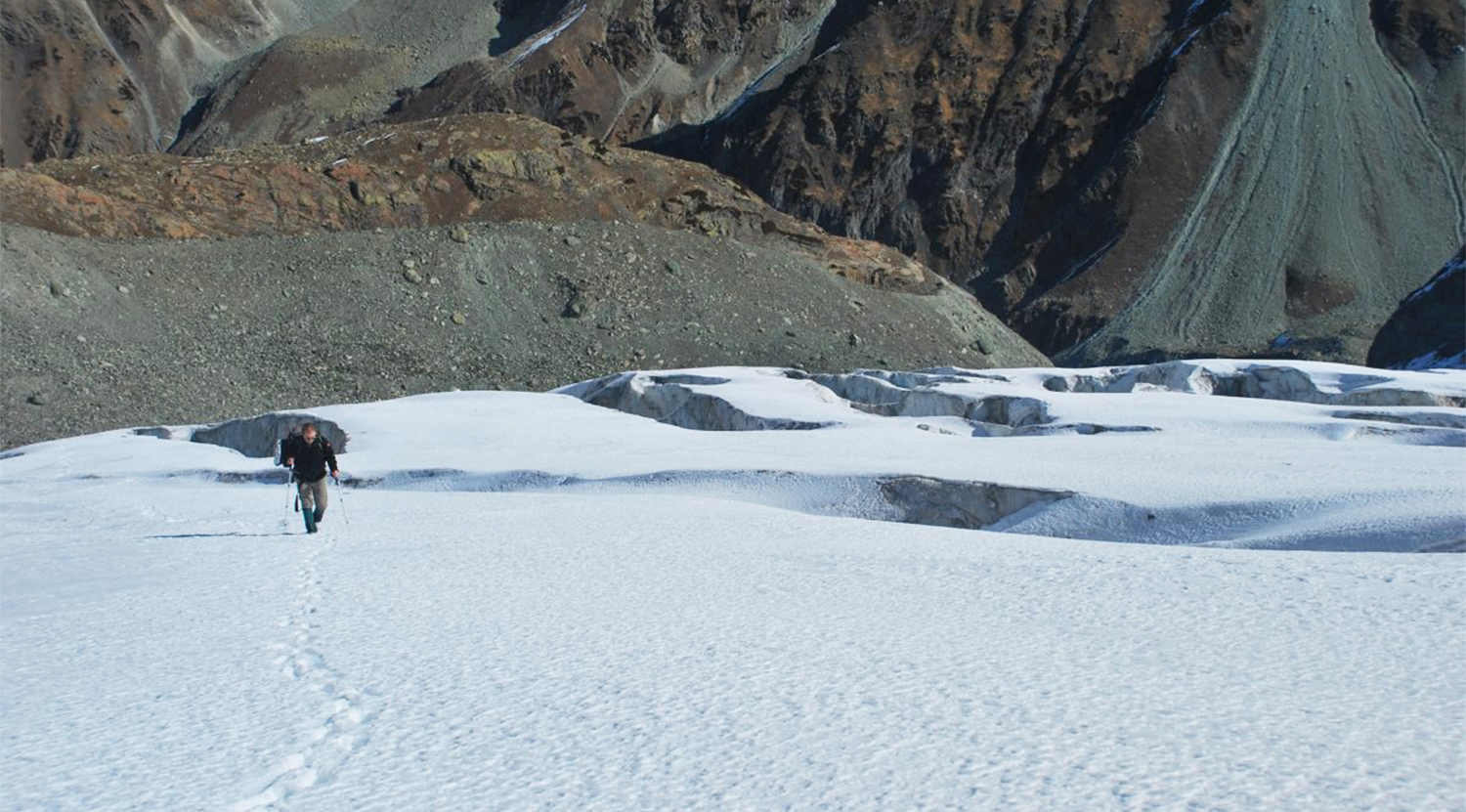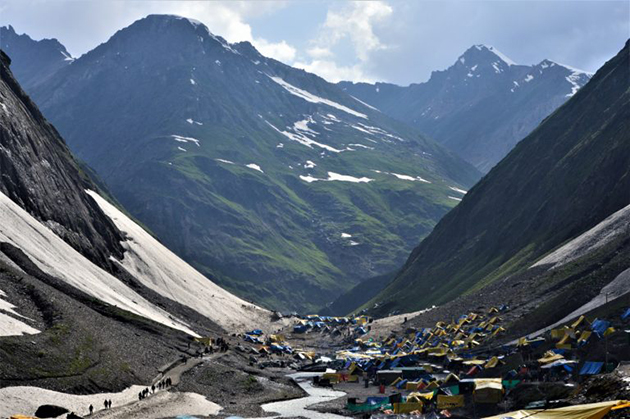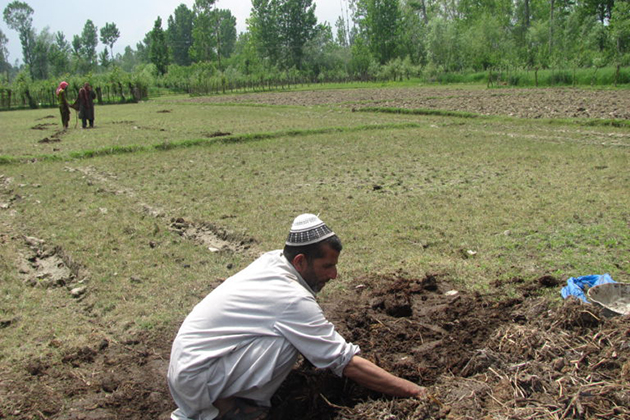Kashmir’s retreating glaciers could also be influenced by local land use change
- Scientists said that rapid retreating of Kolahoi and other glaciers in the region is largely attributable to global factors and climate driven by the local land-use changes.

- Kolahoi glacier, the largest glacier in Kashmir Himalayas, has lost 23% area since 1962 and has fragmented into smaller parts.
- The change in the climate system over Kashmir is driven by global factors and larger atmospheric circulations while the local climate, driven by the local land use changes, also has some influence.
- Area under irrigation-intensive agriculture has shrunk by 39%, whereas the built-up area has expanded by 476.19% at a rate of 12.53% per year between 1980 and 2018 in Kashmir.Kolahoi Glacier, the largest glacier in Kashmir Himalayas which feeds two major tributaries of the River Jhelum – Lidder and Sindh – has further reduced in area over three years, a new research paper has revealed, as it compared its recent findings to that of a 2017 study. Scientists said that rapid retreating of Kolahoi and other glaciers in the region is largely attributable to global factors and climate driven by the local land-use changes also has some influence on glacier-retreat.
“Kolahoi glacier has rapidly receded due to climatic changes prevalent over the Kashmir region. The glacier has lost 23% area since 1962 (from 13.73 sq km in 1962 to 10.49 sq km in 2018) and has fragmented into smaller parts. The snout retreat rates also suggest that the glacier has been in an imbalanced state between 1962 and 2018 and is not approaching equilibrium,” the paper, published in the international journal Water on April 19, 2020, has revealed. A state of equilibrium for the glacier would be when there is no disparity between the melting process and the snow accumulation over the glacier through annual precipitation.
“Glaciers gaining and losing approximately the same amount of snow and ice are thought of as ‘in equilibrium’, and will neither advance nor recede,” writes Betham Davies about glacier mass balance in Antarcticglaciers.org, a website on Antarctic glaciology.
“The exacerbated snout retreat rates of the four parts of the glacier are driven by increasing warming that has impacted the snow accumulation on the glacier,” says the paper. An earlier research paper published in 2017, had revealed that Kolahoi glacier has lost 20% of the area (2.81 sq km) as compared to area of the glacier in 1962 (13.73 sq km).
Irfan Rashid, one of the authors of the latest published research on Kolahoi, said that he and his fellow researchers not only studied the retreating of the glacier, but also its impact on the stream-flow and the resultant land-use changes downstream. “Our research revealed rapid depletion of the glacier as well as massive land-use changes downstream,” Rashid told Mongabay-India. Rashid was also one of the author on the 2017 paper.
According to Rashid, he has been noticing a relentless decline in the area of the Kolahoi glacier in his annual visits to the glacier. “I visit Kolahoi every year and I see the glacier retreating at a very great pace,” Rashid said and added that most of the glaciers in Kashmir are behaving the same way.
“Glaciers in Kashmir have reached critical mass,” he said and added that there is a problem with their mass balance. According to Davies, mass balance of a glacier “can be thought of as the ‘health of a glacier’; glaciers losing more mass than they receive will be in negative mass balance and so will recede.”

Commenting on the decreasing stream-flow due to depleting glaciers in Kashmir, Rashid said that most of the 64 gauging stations at different places on Kashmir’s river system have shown statistically significant depleting trends in flow both annually and seasonally except in springs. He added that they didn’t study as to what extent local factors such as massive land-use change are contributing to retreating of glaciers in Kashmir, but he opined that “local factors might be playing some role.”
Overall glaciers in Kashmir show higher retreat compared to rest of Indian Himalayas
Earth scientist and prominent glaciologist, Shakil Ahmad Romshoo, who heads the department of Earth Sciences at University of Kashmir and has been constantly involved in research on glaciers in Kashmir, including the 2017 research on Kolahoi, said that Kolahoi glacier is not the only glacier which is retreating at a faster rate, but being the largest glacier in the Kashmir basin, it attracts much attention.
“The Kolahoi glacier is not retreating differently from other glaciers in the Kashmir valley. Overall, the glaciers in the Kashmir valley have shown higher retreat and higher negative mass changes compared to other glaciers in the rest of the Indian Himalaya,” Romshoo said.
The recession and mass loss of the glaciers in Kashmir, Romshoo said, is controlled by the climate change, particularly by the significant changes in the form of precipitation.
“The change in the climate system over Kashmir is driven by global factors and larger atmospheric circulation like Western Disturbances and have also small influence of the local climate (driven by the local land use changes such as deforestation and conversion of agricultural land into built-up area ),” he said.
Reduced stream-flow and land use changes
According to the new research paper, by scientists from School of Earth and Environmental Sciences, University of Kashmir and Department of Environmental Science, Nichols College, United State of America, the area under irrigation-intensive agriculture in Lidder watershed in south Kashmir has shrunk by 39%, whereas the orchards have expanded by 177% from 1980 to 2017. The built-up area has expanded by 476.19% (62.81km2) at a rate of 12.53% per year between 1980 and 2018 with a persistent increase across different periods.
“On the basis of preliminary informal interviews, our analysis suggested that the land system changes are a cumulative effect of depleting stream-flows and economic dividends from apple orchards,” the paper says.
The researchers have conducted informal interviews with 142 people during field visits to the Lidder watershed in 2019 and the majority of the farmers (64%) have attributed economic reasons for agriculture to orchard conversions while 30% have attributed the changes to depleting stream-flows.
Romshoo also said that the change in the land system over Kashmir valley is mostly driven by the economic considerations and less by the depletion of stream-flows though, there are certain pockets in Kashmir, particularly in the north where the stream-flow depletion has trigged the conversion of paddy lands into orchards.
“The conversion of paddy land into horticultural land is also happening due to the promotion of the high-density horticulture in Kashmir. So, it is expected that the rate of the land use conversion shall go up further,” Romshoo said.
The conversion of water-intensive paddy land into horticultural land, Romshoo said, will have a significant impact on land surfaces and will lead to the conservation of water in Kashmir.
“One would hope that this change from paddy to horticulture in Kashmir is better informed and promoted as a climate change adaptation strategy with long-term sustainable and perspective planning,” he said and added that, in the wake of consistently depleting stream-flows in Kashmir, a strategy for agriculture needs to be adopted.

When Mongabay-India asked this question to Kashmir’s director for agriculture, Altaf Andrabi, he said that his department is already in the process of implementing a strategy for agricultural sustainability in the region.
“We are planning to create several Special Agricultural Zones across Kashmir which will be based on climatic, physiographic and other factors. Our department, in consultation with other departments and agricultural Institutes will develop an agricultural zone map with an area-specific approach befitting the microenvironmental conditions,” Andrabi said and added that “we have to ensure agricultural sustainability at all costs.”
According to the official records at the agriculture department, Kashmir’s economy is predominately agriculture dependent and nearly 70% of the population is directly or indirectly engaged in agricultural and allied occupations.
This article first appeared on Mongabay.







